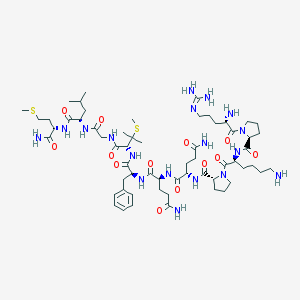

You can:
| Name | CHEMBL405422 |
|---|---|
| Molecular formula | C60H100N18O13S2 |
| IUPAC name | (2S)-2-[[(2R)-1-[(2S)-6-amino-2-[[(2S)-1-[(2S)-2-amino-5-(diaminomethylideneamino)pentanoyl]pyrrolidine-2-carbonyl]amino]hexanoyl]pyrrolidine-2-carbonyl]amino]-N-[(2S)-5-amino-1-[[(2S)-1-[[(2R)-1-[[2-[[(2S)-1-[[(2S)-1-amino-4-methylsulfanyl-1-oxobutan-2-yl]amino]-4-methyl-1-oxopentan-2-yl]amino]-2-oxoethyl]amino]-3-methyl-3-methylsulfanyl-1-oxobutan-2-yl]amino]-1-oxo-3-phenylpropan-2-yl]amino]-1,5-dioxopentan-2-yl]pentanediamide |
| Molecular weight | 1345.69 |
| Hydrogen bond acceptor | 18 |
| Hydrogen bond donor | 15 |
| XlogP | -3.0 |
| Synonyms | BDBM50030166 Arg-Pro-Lys-Pro-Gln-Gln-Phe-Pen(S-Me)-Gly-Leu-Met |
| Inchi Key | KTQLHGMKWNACND-LLTFUCSQSA-N |
| Inchi ID | InChI=1S/C60H100N18O13S2/c1-34(2)31-41(52(85)71-37(49(65)82)25-30-92-5)70-47(81)33-69-56(89)48(60(3,4)93-6)76-53(86)42(32-35-15-8-7-9-16-35)75-51(84)38(21-23-45(63)79)72-50(83)39(22-24-46(64)80)73-54(87)44-20-14-29-78(44)58(91)40(18-10-11-26-61)74-55(88)43-19-13-28-77(43)57(90)36(62)17-12-27-68-59(66)67/h7-9,15-16,34,36-44,48H,10-14,17-33,61-62H2,1-6H3,(H2,63,79)(H2,64,80)(H2,65,82)(H,69,89)(H,70,81)(H,71,85)(H,72,83)(H,73,87)(H,74,88)(H,75,84)(H,76,86)(H4,66,67,68)/t36-,37-,38-,39-,40-,41-,42-,43-,44+,48+/m0/s1 |
| PubChem CID | 44288033 |
| ChEMBL | CHEMBL405422 |
| IUPHAR | N/A |
| BindingDB | 50030166 |
| DrugBank | N/A |
Structure |  |
| Lipinski's druglikeness | This ligand has more than 5 hydrogen bond donor. This ligand has more than 10 hydrogen bond acceptor. This ligand is heavier than 500 daltons. |
You can:
| GLASS ID | Name | UniProt | Gene | Species | Length |
|---|---|---|---|---|---|
| 177952 | Neuromedin-K receptor | P16177 | Tacr3 | Rattus norvegicus (Rat) | 452 |
| 177953 | Substance-K receptor | P16610 | Tacr2 | Rattus norvegicus (Rat) | 390 |
| 177951 | Substance-P receptor | P14600 | Tacr1 | Rattus norvegicus (Rat) | 407 |
zhanglab![]() zhanggroup.org | +65-6601-1241 | Computing 1, 13 Computing Drive, Singapore 117417
zhanggroup.org | +65-6601-1241 | Computing 1, 13 Computing Drive, Singapore 117417